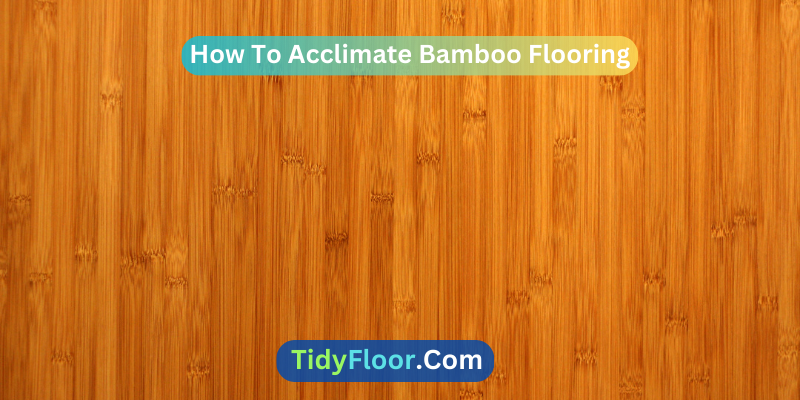Bamboo flooring has gained popularity in recent years due to its sustainability, durability, and unique aesthetic appeal. However, one critical aspect of ensuring the longevity and stability of bamboo flooring is the acclimation process. It is crucial to learn how to acclimate bamboo flooring if you want a seamless bamboo floor.
Acclimating bamboo flooring is essential for stability and adjustment to the moisture condition. Prepare the area, unbox, and stack planks with plastic sheeting. Monitor moisture and temperature. Gradually unpack before installing for lasting results.
In this guide, we will take you through a step-by-step process to properly acclimate bamboo flooring for a successful installation. Keep reading and learn about acclimating bamboo flooring in detail.
How To Acclimate Bamboo Flooring Prior to Installation: 7 Step-by-Step Process
Bamboo flooring acclimation is a crucial step of installation to ensure the right fit and adjustment of the bamboo to the space and weather conditions. In this guide, you will find the exact steps for acclimating bamboo.
Step 1: Prepare the Installation Area
Ensure that the installation area is ready for acclimation. The space should be clean, dry, and at a stable temperature, ideally mirroring the conditions that the room will have after the installation. This prevents any unnecessary changes that could affect the acclimation process.
Step 2: Unbox the Bamboo Flooring
Carefully unbox the bamboo flooring planks and stack them in the installation area. Leave sufficient space between the planks for air circulation. Avoid placing the planks directly on the floor to prevent moisture transfer from the ground.
Step 3: Use Plastic Sheeting
Lay plastic sheeting over the stacks of bamboo planks. This helps slow down moisture exchange with the surrounding air while still allowing the bamboo to acclimate gradually. Secure the edges of the plastic sheeting to create a sealed environment.
Step 4: Monitor Moisture Levels
Use a moisture meter to regularly check the moisture content of both the bamboo flooring planks and the surrounding air. Aim for a moisture content that is consistent with the normal humidity levels of the room. This step might take several days to a couple of weeks, depending on the initial moisture content and the environmental conditions. Note that bamboo flooring acclimation time can vary as per the conditions.
Step 5: Monitor Temperature
In addition to moisture levels, it’s essential to monitor the temperature in the installation area. Fluctuations in temperature can impact the acclimation process. Maintain a stable temperature similar to what the room will experience during regular use.
Step 6: Gradual Unpacking
After the bamboo flooring planks have reached a moisture content in line with the installation area, you can begin unpacking them. Do this gradually, installing a few planks at a time. This ensures that the remaining planks continue to acclimate while you work.
Step 7: Installation
With the bamboo flooring planks now properly acclimated, you can proceed with the installation process. Follow the manufacturer’s guidelines for installation, using appropriate tools and techniques.
8 Tips About How to Acclimate Engineered Bamboo Flooring
Acclimating engineered bamboo flooring is a critical step in ensuring a successful and long-lasting installation. Engineered bamboo flooring consists of a real bamboo top layer bonded to multiple layers of plywood or similar materials. These tips will guide you through the process of acclimating engineered bamboo flooring for optimal results:
- Understand Engineered Bamboo Flooring:
Engineered bamboo flooring differs from solid bamboo as its construction includes layers that can react differently to moisture. While the bamboo layer is still susceptible to changes in humidity, the underlying layers provide stability. This makes proper acclimation essential to ensure all layers adapt harmoniously.
- Prepare the Installation Area:
Clear the installation area of debris and moisture. The environment should reflect the room’s typical conditions after installation. This means maintaining the desired temperature and humidity levels that the room experiences regularly.
- Unbox and Stack:
Carefully unbox the engineered bamboo flooring planks and organize them in stacks. Leave space between each plank to allow air circulation. Avoid placing them directly on the ground to prevent moisture transfer.
- Use Plastic Sheeting:
Cover the stacks of bamboo planks with plastic sheeting. This slows down the moisture exchange process, allowing the planks to acclimate gradually. Secure the edges of the plastic to create a sealed environment.
- Monitor Moisture and Temperature:
Regularly use a moisture meter to measure the moisture content of both the bamboo planks and the surrounding air. Aim for a moisture level that matches the anticipated room humidity. Also, keep track of the temperature to maintain a stable environment.
- Be Patient:
Acclimation is not a rushed process. Depending on initial moisture levels and environmental factors, it could take several days or more. Patience ensures that the bamboo flooring adjusts properly, reducing the risk of problems later.
- Gradual Unpacking:
Once the bamboo planks have reached the desired moisture content, gradually unpack them. This ensures that the remaining planks continue acclimating as you begin the installation process.
- Expert Tip:
For the best results, consult the manufacturer’s guidelines for acclimation duration and conditions specific to the engineered bamboo flooring you’ve chosen.
6 Mistakes to Properly Acclimate Cali Bamboo Flooring
Acclimating bamboo flooring, especially Cali Bamboo, is an essential step to ensure its proper installation and prevent issues like warping or buckling. Here are some mistakes to avoid during Cali bamboo flooring acclimation:
- Skipping Acclimation Altogether:
One of the biggest mistakes is entirely skipping the acclimation process. Bamboo flooring needs time to adjust to the environment to prevent warping, buckling, or gaps after installation.
- Insufficient Acclimation Time:
Rushing the acclimation process is a recipe for disaster. Insufficient time for the bamboo planks to adjust to humidity and temperature changes can result in flooring problems down the road.
- Neglecting the Manufacturer’s Recommendations:
Every bamboo flooring product may have specific acclimation guidelines from the manufacturer. Ignoring these recommendations can lead to improper acclimation, causing issues with the flooring.
- Inadequate Moisture and Temperature Monitoring:
Not monitoring moisture and temperature levels during acclimation can lead to problems. Regularly checking and maintaining the correct conditions is crucial for the bamboo planks to adjust properly.
- Not Simulating Real Installation Conditions:
If the installation area’s conditions differ significantly from the actual living environment, the acclimation process may be ineffective. Always aim to simulate the room’s natural conditions.
- Overstacking or Overcrowding the Bamboo Planks:
Stacking too many planks on top of each other or crowding them together can impede proper airflow and hinder acclimation. Leave enough space for air circulation between the planks.
FAQs:
Why Is Acclimating Bamboo Flooring Necessary?
Acclimation allows bamboo flooring to adjust to the room’s humidity and temperature, reducing the risk of issues like warping or gaps post-installation.
How Long Does The Bamboo Acclimation Process Take?
The duration varies depending on initial moisture levels and environmental conditions. It can take anywhere from a few days to a couple of weeks for the bamboo planks to properly acclimate.
Can I Skip The Bamboo Acclimation Process?
Skipping acclimation increases the likelihood of future problems. Acclimating bamboo flooring is a preventive measure that ensures its longevity and stability.
What’s The Ideal Moisture Content For Acclimated Bamboo?
The ideal moisture content should match the normal humidity levels of the room, generally ranging between 6% to 9% for bamboo flooring.
Can I Speed Up The Acclimation Process?
It’s not advisable. Rapid acclimation could lead to uneven moisture levels within the bamboo, causing issues like cracking or warping after installation.
Can I Acclimate Bamboo Flooring In Its Final Installation Area?
Yes, it’s recommended. Acclimate the planks in the actual room where they will be installed to ensure they adapt to the specific conditions they’ll face.
What If My Room’s Humidity Levels Are Constantly High Or Low?
If the room’s humidity levels are consistently high or low, it’s crucial to address this issue before installing bamboo flooring, as extreme humidity can still cause problems post-acclimation.
Should I Remove The Plastic Sheeting After Acclimation?
Yes, once the bamboo flooring has acclimated, remove the plastic sheeting to allow the planks to “breathe” and equalize with the room’s conditions.
Can I Install The Flooring Immediately After Acclimation?
While it’s tempting, wait a few days after acclimation before installing. This period allows the bamboo planks to settle fully, reducing the risk of issues during installation.
Can I Acclimate Bamboo Flooring During Different Seasons?
Yes, you can acclimate bamboo flooring during different seasons, but be mindful of extreme weather conditions that could affect humidity levels. Monitor closely to ensure proper acclimation regardless of the season.
Conclusion
Learning the steps of how to acclimate bamboo flooring is a crucial step to ensure a successful and durable installation. By allowing the flooring planks to adjust to the environmental conditions of the installation area, you significantly reduce the risk of problems such as warping or gaps.
Acclimate the bamboo floor in the right way to enjoy the beauty and longevity of your bamboo flooring for years to come.


